| Helianthus annuus Sunflower | |
|---|---|
 | |
| Scientific classification | |
| Kingdom: | Plantae |
| (unranked): | Angiosperms |
| (unranked): | Eudicots |
| (unranked): | Asterids |
| Order: | Asterales |
| Family: | Asteraceae |
| Subfamily: | Helianthoideae |
| Tribe: | Heliantheae |
| Genus: | Helianthus |
| Binomial name | |
| Helianthus annuus L. | |
Sunflower seeds were taken to Europe in the 16th century where, along with sunflower oil, they became a wide-spread cooking ingredient. Sunflower leaves can be used as a cattle food, while the stems contain a fibre which may be used in paper production.
Contents
|
Description
With sunflower, what is usually called the flower is actually a flower head (also known as a composite flower) of numerous florets, (small flowers) crowded together. The outer petal-bearing florets are the sterile ray florets and can be yellow, red, orange, or other colors. The florets inside the circular head are called disc florets, which mature into seeds.The florets within the sunflower's cluster are arranged in a spiral pattern. Typically each floret is oriented toward the next by approximately the golden angle, 137.5°, producing a pattern of interconnecting spirals where the number of left spirals and the number of right spirals are successive Fibonacci numbers. Typically, there are 34 spirals in one direction and 55 in the other; on a very large sunflower there could be 89 in one direction and 144 in the other.[1][2][3] This pattern produces the most efficient packing of seeds within the flower head.[4][5][6]
Sunflowers most commonly grow to heights between 1.5 and 3.5 m (5–12 ft). Scientific literature[who?] reports that a 12 m (40 ft), traditional, single-head, sunflower plant was grown in Padua in 1567. The same seed lot grew almost 8 m (26 ft) at other times and places, including Madrid.[citation needed] During the 20th century, heights of over 8 m have been achieved in both Netherlands and Ontario, Canada.[citation needed]
Heliotropism
Despite the common belief[by whom?], mature sunflowers do not track the sun. The mature flowerheads typically face east; only young sunflowers exhibit heliotropism (sun turning): the leaves and buds of young sunflowers follow the sun so that their orientation changes from east to west during the course of a day.[7] The movements become a circadian response and when plants are rotated 180 degrees, the old response pattern is still followed for a few days, with leaf orientation changing from west to east instead.[8] The leaf and flowerhead bud phototropism occurs while the leaf petioles and stems are still actively growing, but once mature, the movements stop. These movements involve the petioles bending or twisting during the day then unbending or untwisting at night.[9]History
The sunflower is native to Central America. The evidence thus far is that it was first domesticated in Mesoamerica, present day Mexico, by at least 2600 BC.[10] It may have been domesticated a second time in the middle Mississippi Valley, or been introduced there from Mexico at an early date, as maize was. The earliest known examples of a fully domesticated sunflower north of Mexico have been found in Tennessee and date to around 2300 BC[citation needed]. Many indigenous American peoples used the sunflower as the symbol of their solar deity, including the Aztecs and the Otomi of Mexico and the Incas in South America. Francisco Pizarro was the first European to encounter the sunflower in Tahuantinsuyo, Peru. Gold images of the flower, as well as seeds, were taken back to Spain early in the 16th century. Some researchers argue that the Spaniards tried to suppress cultivation of the sunflower because of its association with solar religion and warfare.[11]During the 18th century, the use of sunflower oil became very popular in Europe, particularly with members of the Russian Orthodox Church because sunflower oil was one of the few oils that was not prohibited during Lent, according to some fasting traditions.
Cultivation and uses
Sunflower oil, extracted from the seeds, is used for cooking, as a carrier oil and to produce margarine and biodiesel, as it is cheaper than olive oil. A range of sunflower varieties exist with differing fatty acid compositions; some 'high oleic' types contain a higher level of monounsaturated fats in their oil than even olive oil.
The cake remaining after the seeds have been processed for oil is used as a livestock feed. Some recently developed cultivars have drooping heads. These cultivars are less attractive to gardeners growing the flowers as ornamental plants, but appeal to farmers, because they reduce bird damage and losses from some plant diseases. Sunflowers also produce latex and are the subject of experiments to improve their suitability as an alternative crop for producing hypoallergenic rubber.
Traditionally, several Native American groups planted sunflowers on the north edges of their gardens as a "fourth sister" to the better known three sisters combination of corn, beans, and squash.[12] Annual species are often planted for their allelopathic properties.[citation needed]
However, for commercial farmers growing commodity crops, the sunflower, like any other unwanted plant, is often considered a weed. Especially in the midwestern US, wild (perennial) species are often found in corn and soybean fields and can have a negative impact on yields.
Sunflowers can be used to extract toxic ingredients from soil, such as lead, arsenic and uranium. They were used to remove cesium-137 and strontium-90 from a nearby pond after the Chernobyl disaster[13] (see phytoremediation).
Sunflower genome
The sunflower, Helianthus annuus, genome is diploid with a base chromosome number of 17 and an estimated genome size of 2871–3189 Mbp.[14] Some sources claim its true size is around 3.5 billion base pairs (slightly larger than the human genome).[15]Mathematical model of floret arrangement
A model for the pattern of florets in the head of a sunflower was proposed by H. Vogel in 1979.[16] This is expressed in polar coordinatesIn culture
- The sunflower is the state flower of the US state of Kansas, and one of the city flowers of Kitakyūshū, Japan.
- The sunflower is often used as a symbol of green ideology, much as the red rose is a symbol of socialism or social democracy. The sunflower is also the symbol of the Vegan Society.
- During the late 19th century, the flower was used as the symbol of the Aesthetic Movement.
- Subject of Van Gogh's most famous still life, Sunflowers
- The sunflower is the national flower of Ukraine.
- The sunflower was chosen as the symbol of the Spiritualist Church for many reasons, but mostly because it turns toward the sun as "Spiritualism turns toward the light of truth". Modern Spiritualists always have art or jewelry with sunflower designs.[18]
International Sunflower Guerrilla Gardening Day
International Sunflower Guerrilla Gardening Day is 1 May.[19] It is a day when guerrilla gardeners around the world plant sunflowers in their neighborhood, typically in neglected public places such as tree pits, shabby flower beds and bare roadside verges. It has taken place since 2007 and was conceived by guerrilla gardeners in Brussels,[20] (who go by the name of The Brussels Farmers). They declared it Journée Internationale de la Guérilla Tournesol. It has been championed by guerrilla gardeners around the world, notably by GuerrillaGardening.org [21] and participation has grown each year since then. In 2010 more than 5000 people signed up to the event from North America, Europe and Asia.[22] Although sunflower sowing at this time of the year is limited to relatively temperate parts of the northern hemisphere, this day is also marked in other parts of the world by planting appropriate to the season.Varieties
The following are varieties of sunflowers (in alphabetical order):
|
|
|
Other species
There are many species in the sunflower genus Helianthus, and many species in other genera that may be called sunflowers.- The Maximillian sunflower (Helianthus maximillianii) is one of 38 species of perennial sunflower native to North America. The Land Institute and other breeding programs are currently exploring the potential for these as a perennial seed crop.
- The Sunchoke [1] (Jerusalem artichoke or Helianthus tuberosus) is related to the sunflower, another example of perennial sunflower.
- The Mexican sunflower is Tithonia rotundifolia. It is only very distantly related to North American sunflowers.
- False sunflower refers to plants of the genus Heliopsis.
 Unknown
Unknown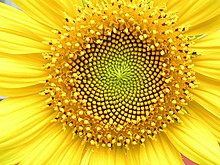


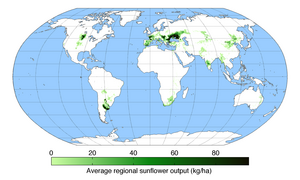
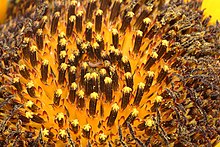
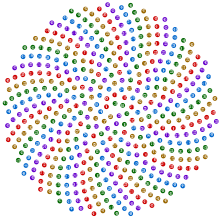




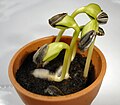












0 komentar:
Post a Comment